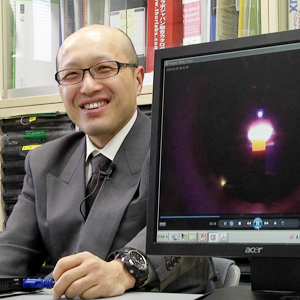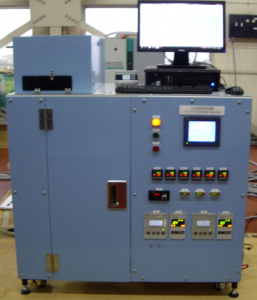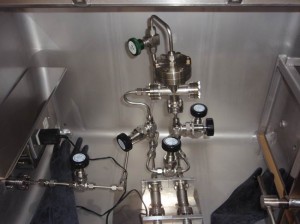- HOME
- Wow! Cool Laboratory [Researcher Introduction]
- Toshihiro Shimada
Wow! Cool Laboratory [Researcher Introduction]

Division of Applied Chemistry,
Research Group of Inorganic Materials Chemistry,
Laboratory of Solid State Chemistry
Research fields: Solid-state chemistry
Research themes: Organic semiconductors, inorganic nano-materials, surface physics, crystal growth
E-mail: shimadat[a]eng.hokudai.ac.jp
The Development of Innovative Devices for the Measurement and Assessment of Gas Barrier Performance
Contribution to Production Management for Flexible Organic Devices
Investigating Solid-state Chemistry Along the Border Between Physics and Engineering
Development of Equipment Necessary for the Research
Professor Toshihiro Shimada took the post of professor at the Hokkaido University Faculty of Engineering Solid State Chemistry Laboratory in April 2010. He was previously an associate professor at The University of Tokyo, School of Science, Department of Chemistry, where he was engaged in research in areas such as organic semiconductors, organic thin films, and high-energy carbon science.
“Chemical research is quite highly matured in both pure science and engineering, and we are now able to control and measure materials at the atomic and molecular levels. Taking construction as an example, matters like the types of nail and how to drive them in, and what is the right kind of nail to use in a given situation, have been resolved to some extent, and the discussion has moved on, to “what kind of home would it be good to build?” At that level, the boundary between science and engineering gets blurred, so the shift from faculty of science to that of engineering within me was a natural process”.
Professor Shimada is frequently involved in developing his own equipments, and in some circumstances, that has led on to various research projects. He is currently interested in subjects such as substances for which it is difficult to control reactions for synthesis, such as diamonds and carbon nanotubes, and the development of catalysts that are usable in high-temperature and high-energy environments. He says “the equipment and devices needed in these fields are almost non-existent, so we have to start by producing those devices from scratch”. The development of instruments to measure moisture permeation, which Professor Shimada was previously working on, is one of the more noteworthy fruits of that equipment development.
Developing instruments for the high-sensitivity measurement of moisture permeation rates
Major contribution to production management for flexible organic devices
It is known that in the manufacturing processes for flexible organic devices such as organic EL and organic photovoltaic cells, moisture and oxygen cause semiconductors to deteriorate, greatly shortening their life time. Therefore, the surfaces are coated with materials with water vapor barrier properties, but raising the level of the measurement technology for barrier performance assessment of those coatings was a major challenge.
To meet that need, Professor Shimada developed, through joint research with companies, an instrument for measuring the barrier performance of organic membranes, which had a major impact on the field of organic device manufacturing.
“Previous instruments took between a few weeks and a few months to produce a result, and their sensitivity was low, so they were inadequate for production management in manufacturing facilities. The “moisture permeation measurement instrument” that we developed obtains results in around one week at the longest, so it enabled a large time reduction”.
The improved precision and the shorter measurement time were made possible by the introduction of a cooled trap to collect water vapor that has passed through the sample. (Commentary 1)
“Moisture is adsorbed into a cooled trap, and substances other than water vapor are pumped out, then the moisture is measured with a mass spectrometer placed in ultrahigh vacuum. This makes the sensitivity of the detector 300 times higher than that of previous instruments. The completely new measurement principle of first collecting the moisture and then measuring it all at once led to great results”.
The barrier performance assessment of flexible organic devices requires precise measurement of quantities of water vapor below 10-6g/㎡/day, which is equivalent to relative humidity of 0.0000001% (10-9 as a ratio to the number of molecules of atmosphere) or less. This instrument meets that requirement. It is also quick to eliminate remaining water after the specimen is measured, so repeated measurements can be taken in a short time. Gases other than water vapor can also be measured, so the instrument is expected to be used in the fields of medicine and food.
“The measurement time is short and repeated measurement is possible, so it can be used in production management in manufacturing facilities. Even if a new coating material was developed, it took nearly half a year to test it, so that wasn’t a viable business. Considering the development speed of products that make use of flexible organic devices, I think there is a very strong need for faster and more advanced barrier performance assessment”.
Cooperation Between Industry, Government and Academia Yields the Greatest Effects
Aiming to Establish Technologies That Will Become Global Standards
This research was chosen for the “Projects to Supporting Industry the advancement of strategic core technologies (Ministry of Economy, Trade and Industry)” for 2012, and he is working to advance it to a higher level by 2014.
“Our aim with this project is standardization. At present, even if it is possible to measure the absolute volume of water, there was no method for calibration, so there is no reference for checking whether the values obtained are right. In our research, we use the “standard conductance element” (Commentary 2), which is a technology patented by AIST, to calibrate mass spectrometers”.
Professor Shimada says the key to developing the instrument was the three-way cooperation between the university, AIST, and the company.
“I think it was very important that each side had its strengths, and they complemented each other in our efforts. The company provided funding, personnel, and the site for performing the experiments, the AIST group had experts in measuring quantities, and world-class technologies related to ultrahigh vacuum, and the University provided the theory and ran the simulations. This first became possible with the combination of the three parties, and it couldn’t have been done if any one of them had been missing”.
In future, they will make measurement more accurate, and plan to develop standard specimens as indices for measurement.
“By establishing standard specimens, we can check our own measurement instruments, and also check whether the instruments of other manufacturers are measuring properly. Identifying standard quantities of water vapor permeation advances the assessment technology, and we expect it to make a major contribution to improving production management for flexible organic devices.
Other than this project, Professor Shimada has many others in progress at the same time, and is constantly polishing ideas in his head. The development of the instrument started from him making a prototype with his own hands but, he says, “Talking to all kinds of people and working with them in research work broadens my perspective and often opens up new doors for research, so I want young researchers and students to value getting broadly involved with things”. The wide range of connections he has built up is an indispensable element in Professor Shimada’s research work.
| Note | Taking examples from dairy life, plastic wrap film has 102, and the highst value is 10-0 of PET bottles for carbonated drinks. Barrier films for flexible organic devices must have 6 to 8 orders magnitude better charactaristics. |
|---|---|
| Commentary 1 | Configuration diagram of the moisture permeation volume measurement instrument |
| Commentary 2 | Standard Conductance Element |

Fig. 1: Water vapor transmission rate measurement system

Fig. 2: Human-operated prototype machine that was used to confirm the principle of the water vapor transimision measurement
It was placed in a glove box to shut out the water vapor in atmosphere. Prof. Shimada continuously operated nine valves one by one almost every minutes for four hours.
